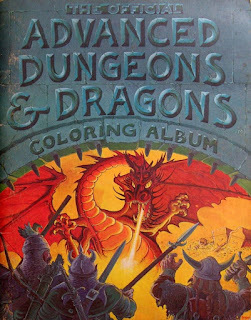Retrospective: The Official Advanced Dungeons & Dragons Coloring Album
 Over the years, I've made occasional posts in which I've shared an image from The Official Advanced Dungeons & Dragons Coloring Album, but I've never written a full Retrospective post about this curious – and amazing – product. Today, I intend to correct that oversight.
Over the years, I've made occasional posts in which I've shared an image from The Official Advanced Dungeons & Dragons Coloring Album, but I've never written a full Retrospective post about this curious – and amazing – product. Today, I intend to correct that oversight.
Released in 1979 just a few months prior to the disappearance of James Dallas Egbert III, the Coloring Album is a remarkable relic of the time just before Dungeons & Dragons ascended to the heights of name recognition that it's continued to enjoy ever since. Consequently, this 32-page, oversized book is something of a rarity nowadays. I knew nothing of its existence until I started writing this blog, despite the fact that it appeared shortly before I began playing D&D. I've likewise never seen a physical copy of thing, though one can easily find electronic versions online with only a little effort.
One might well imagine that, aside from the simple oddity of an AD&D coloring book, there's not much to say about this product, but that would be mistaken. Let's start with the obvious – the illustrations. In addition to the beholder battle I included earlier this week, there's this one, featuring a bulette:
 And this one in which the adventurers discover a vault filled with treasure:
And this one in which the adventurers discover a vault filled with treasure:
 These only scratch the surface of the universally intricate and evocative art found throughout the Coloring Album. I may share some additional pages from the book in subsequent posts, because they're very much worthy of further comment.
These only scratch the surface of the universally intricate and evocative art found throughout the Coloring Album. I may share some additional pages from the book in subsequent posts, because they're very much worthy of further comment. Equally of note is the artist responsible for all these illustrations: Greg Irons. Irons, who died in 1984 at the age of only 37, was well known in the underground comics scene of the 1970s. Prior to that, he worked as a painter of animation cels for the 1968 Beatles movie, Yellow Submarine. He'd also work in the burgeoning field of original poster art and tattooing. In short, Irons was deeply connected to the artistic counterculture of the period – a counterculture that was at the forefront of promoting fantasy images and themes from The Lord of the Rings to metal and prog rock albums to airbrushed "wizard vans."
The involvement of Irons shouldn't really be a surprise, given that the Coloring Album was published by Troubador Press of San Francisco. Though most of Troubador's titles were activity or coloring books, their audience wasn't just children. They frequently highlighted weird and offbeat interests, especially science fiction, fantasy, and the occult, which attracted many adults to them as well. Troubador treated these subjects seriously. Just as importantly, the company hired some of the best outsider artists to illustrate them with strange, compelling, and often psychedelic artwork that stood out from other similar books of the same time. The Official Advanced Dungeons & Dragons Coloring Album was, therefore, very much a product of the same counterculture that made the 1970s such a chaotic cauldron of creativity.
The Album is also notable for being more than just a coloring book: it's also a game, albeit a very primitive one. The book presents itself as illustrating the various rooms and encounters found within "the depths of the vile dungeon" that holds a mystic talisman to be used "against the hordes of Evil threatening to overwhelm the Kingdom of Good." Included within is a map of the dungeon with simple rules using two six-sided dice to adjudicate battles, as the reader tries to guide his party of adventurers through the dungeon. The scenario and its accompanying text were apparently designed by Gary Gygax himself (who held copyright over the text).
Though not one of Gygax's better adventure scenarios, the text accompanying the illustrations is surprisingly good, filled with lots of details and allusions to elements of D&D, as well as some from his World of Greyhawk setting. References are made to the Lake of Unknown Depths, the Green Dragon Inn, and St. Cuthbert, among a couple of others. It's quite fascinating to look at it now with an eye toward finding things you might have overlooked when you first saw it.
The Official Advanced Dungeons & Dragons Coloring Album is one of those early gaming products that might well qualify as a genuine "treasure." It's certainly one I wish were still readily available, because I think it's not only a fun book in its own right, but also an amazing reminder that D&D and, by extension, all roleplaying games grew up with and were influenced by the underground art scene of the '60s and '70s. It's a reminder of what D&D was like – and perhaps could have become – had it not eventually been seized by a corporatized desire to become a safe consumer product for the masses.
James Maliszewski's Blog
- James Maliszewski's profile
- 3 followers



